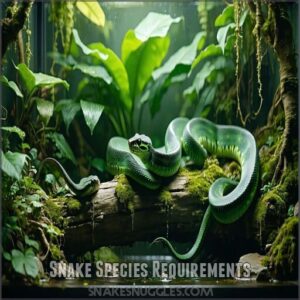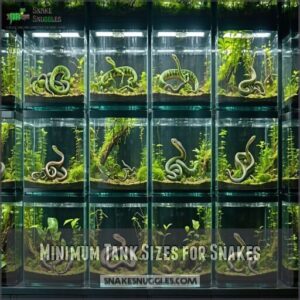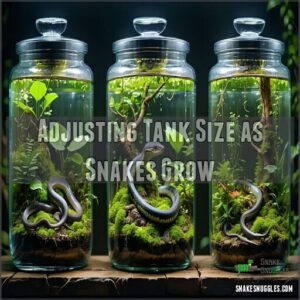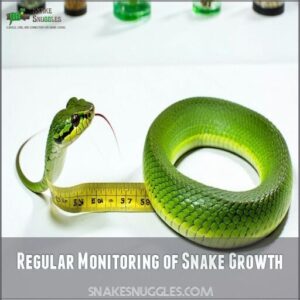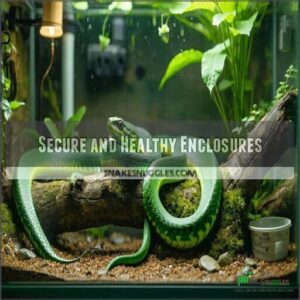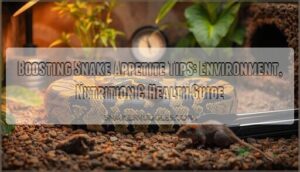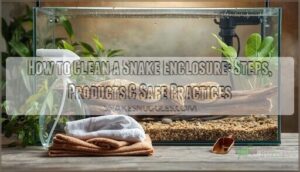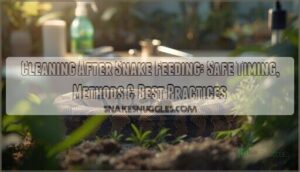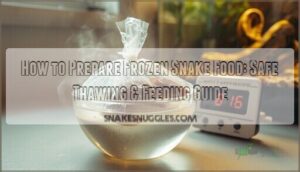This site is supported by our readers. We may earn a commission, at no cost to you, if you purchase through links.
 Finding the right tank size for your snake depends on its species and how it lives.
Finding the right tank size for your snake depends on its species and how it lives.
Ball pythons, known for their shy nature, thrive in a 40-gallon tank, while more active corn snakes need at least 75 gallons to roam.
Boa constrictors, being larger, require 6-8 feet in length to stretch comfortably.
King snakes and garter snakes can be happy in a 30-40 gallon setup, as long as there’s room to explore.
For arboreal snakes like green tree pythons, don’t forget vertical height.
Always plan for growth—juveniles grow fast!
Want to create a habitat that feels like home?
It’s simpler than you’d think.
Table Of Contents
- Key Takeaways
- Snake Species Requirements
- Enclosure Size Guidelines
- Snake Growth and Enclosure
- Creating Naturalistic Habitats
- Secure and Healthy Enclosures
- Frequently Asked Questions (FAQs)
- What size tank does my snake need?
- What is the rule of thumb for snake tank size?
- What size enclosure does a snake need?
- What snakes can live in a 4x2x2 enclosure?
- How big should a king snake tank be?
- What size tank do pythons need?
- How to choose a snake tank?
- How many gallons should a snake tank be?
- How big should my snakes enclosure be?
- What can live in a 4x2x2?
- Conclusion
Key Takeaways
- Match your snake’s tank size to its species, behavior, and growth stage to ensure comfort and proper movement.
- Use the snake’s length as a guide—the combined length and width of the tank should equal or exceed it.
- Provide species-specific features like height for climbers, hiding spots for shy snakes, and temperature gradients for all.
- Regularly upgrade the tank as your snake grows; a cramped enclosure can hurt its health and well-being.
Snake Species Requirements
Each snake species has unique space and environmental needs, so it’s vital to match their tank size to their natural habits.
Understanding these requirements guarantees your pet has enough room to thrive and exhibit its natural behavior.
Ball Python Habitat Needs
When planning your Ball Python’s enclosure, focus on heating gradients (75-85°F ambient, 90°F basking), proper humidity control (50-60%), and essential features like hiding spots and climbing branches.
Choose from substrate types like aspen shavings to maintain moisture.
Snake tank size matters—hatchlings need smaller spaces (20-gallon), while adults require snake habitat dimensions of at least 48″L x 24″W x 24″H for comfort.
You can find various enclosure products online to support your Ball Python’s needs and create a suitable environment with the right enclosure products.
Corn Snake Environment Requirements
Corn snakes thrive in environments suited to their needs.
A proper snake tank size provides comfort, particularly for adults needing at least 120x60x60cm.
Keep the snake happy with a temperature gradient, ranging from a warm 85°F zone to 75°F cooler spots.
As ground-dwelling creatures, they often prefer caves and rocky regions.
- Cozy hiding spots for privacy.
- Climbing decor, like sturdy branches.
- Aspen or soil substrate for natural touch.
Boa Constrictor Space Needs
Boa Constrictors need spacious enclosures matching their adult size—at least 8’L x 4’W x 4’H for comfort.
These semi-arboreal snakes benefit from climbing structures and enrichment options.
A secure snake tank should meet their arboreal needs while supporting their natural temperament.
Follow a reliable snake size guide to guarantee proper snake enclosure size based on their growth and breeding space requirements.
King Snake and Garter Snake Requirements
Boa constrictors need plenty of space, but what about king snakes and garter snakes.
King snakes require a wooden vivarium, at least 34 inches long, with ventilation and a basking zone (85-90°F).
Garter snakes thrive in enclosures 48”L x 24”W x 24”H, with climbing space and bioactive substrate.
Adjust snake enclosure size as they grow.
The checkered garter snake requires tall vegetation in its habitat.
Enclosure Size Guidelines
Choosing the right enclosure size for your snake guarantees it can move freely and exhibit natural behaviors.
By following species-specific guidelines, you’ll create a safe and comfortable habitat that supports your pet’s health and well-being.
Minimum Tank Sizes for Snakes
When creating the perfect habitat for your snake, consider species-specific minimums.
Hatchlings like baby ball pythons thrive in 10-gallon tanks, while adult snakes require larger enclosures—like boa constrictors needing 120 gallons.
Vertical space needs matter for climbers, and upgrading tanks as snakes grow guarantees comfort.
Following a snake tank size guide keeps your pet happy and their enclosure size just right.
Calculating Enclosure Length and Width
When calculating snake tank dimensions, use the Snake Length Ratio: the enclosure’s length and width together should equal or exceed the snake’s length.
For arboreal species, prioritize floor space needs but don’t ignore volume calculations.
Always consider future growth space when choosing a snake species tank. Use this snake tank size guide to find the right fit!
Height Requirements for Arboreal Species
Focusing on species needs, arboreal snakes thrive in enclosures with appropriate height.
Providing climbing space and vertical enrichment is essential, so aim for tank dimensions with adequate enclosure height.
Securely place branches and climbing structures to prevent accidents.
Snake habitat size should allow natural behavior while ensuring safety.
Always match the snake’s tank size to its climbing instincts and activity levels, as this is crucial for the snake’s well-being, considering its need for vertical enrichment and ensuring the enclosure supports its natural behavior.
Substrate and Decor Considerations
Choosing the right substrate and decor is essential for your snake’s comfort.
Substrate types like aspen shavings or coconut fiber help with humidity control.
Opt for decor safety by avoiding sharp edges.
Include enrichment items like climbing structures and hiding spots to mimic a naturalistic habitat.
A well-thought-out naturalistic design supports your snake’s health and encourages their natural behaviors.
Rosy boas, for example, benefit from secure hides to reduce stress.
Snake Growth and Enclosure
As your snake grows, its enclosure needs to keep up to guarantee a healthy and comfortable habitat.
Monitoring your pet’s size regularly helps you determine when it’s time for an upgrade, allowing space for natural movement and behavior.
Adjusting Tank Size as Snakes Grow
Snake growth brings consistent change, so monitoring it’s essential for ensuring a comfortable enclosure.
Monitoring your snake’s growth ensures a comfortable habitat that evolves with their needs, promoting health, happiness, and natural behaviors.
Hatchlings and juveniles grow fast, often requiring quick size upgrades to match their age-related enclosure size.
Consider species variation; some outgrow small tanks quicker.
Proper snake enclosure size allows natural movement, lowers long-term costs, and supports enrichment needs, ensuring your pet thrives through every stage with proper care.
Predicting Adult Snake Size
Understanding your snake’s parental size can help estimate its growth rate and ultimate length.
Different species vary—Corn Snakes average 3-5 feet, while Boa Constrictors can reach 10 feet.
Consult a breeder for accurate predictions.
Long-term planning guarantees your snake’s needs are met as it grows.
Use a snake species guide to estimate max size for proper tank sizing and ensure you can provide the right environment for your snake, considering its potential to reach a certain ultimate length.
Upgrading Enclosures for Comfort and Health
As your snake grows, upgrading the enclosure isn’t just about space; it’s about their happiness and health.
A larger tank supports stress reduction and allows for enrichment options, like climbing branches or hiding spots.
Pay attention to behavioral changes and health indicators—these signals guide snake tank size considerations.
A well-planned habitat promotes snake welfare while aligning with species-specific needs in this essential snake species guide.
Regular cleaning prevents parasites and pests.
Regular Monitoring of Snake Growth
Keeping an eye on your snake’s growth requires tracking its growth rate, shedding frequency, and weight.
Regularly measure snake length and adjust the enclosure size to fit its development.
Check body condition and other health indicators to guarantee comfort and well-being.
Snakes outgrow tanks fast, so monitoring confirms the space matches their needs for natural behavior and proper development, ensuring their overall well-being.
Creating Naturalistic Habitats
When creating a naturalistic habitat for your snake, it’s important to mimic the conditions of its natural environment with the right substrate, décor, and temperature.
This guarantees your pet feels secure, stays healthy, and can exhibit its natural behaviors.
Replicating Desert and Forest Environments
Transform your snake’s tank setup into a naturalistic habitat by matching its species-specific needs.
For desert snakes, choose Desert Substrates like sand, adding rocks and hiding spaces.
Forest species thrive with Forest Decor such as leaves, branches, and safe bark.
Verify the snake enclosure size accommodates movement, using Naturalistic Lighting and Temperature Gradients to mimic their environment.
Think practical, not overcrowded.
Maintaining Temperature and Humidity Levels
Achieving the right heat gradient and humidity is vital for your snake’s health. A temperature gradient lets them choose cozy basking or cooler spots, while humidity control keeps shedding smooth.
Use monitoring equipment like hygrometers and thermostats to check levels daily. Maintaining proper humidity guarantees snake hydration and shedding are ideal.
- Adjust humidity with water bowls, misting, or humidifiers.
- Place thermostats near the basking zone.
- Factor in species variations for seasonal adjustments.
Maintaining proper humidity guarantees snake hydration and shedding are ideal, ensuring a healthy environment for your snake, with proper humidity control.
Providing Hiding Spots and Climbing Structures
A well-designed tank includes secure hiding spots and natural climbing structures.
Snakes feel safer with enclosed spaces, reducing stress and encouraging natural behavior.
Add sturdy branches or shelves for climbing variety, depending on the species.
Use naturalistic decor for snake enrichment while ensuring safety.
Balancing enclosure enrichment with snake behavior creates a healthy, engaging habitat for your pet.
Using Safe and Non-Toxic Substrates
Choosing the right snake substrate keeps your pet healthy and happy.
Avoid toxic options like sand or particle-based substrates, which risk impaction or allergies.
Natural substrates like aspen shavings or coconut fiber are safe and maintain humidity.
Guarantee proper cleaning to prevent mold growth.
To guarantee a safe environment, consider substrate safety considerations when selecting bedding.
Substrate selection impacts enclosure decor, so match it to your snake’s needs—secure, clean, and appropriately designed.
Secure and Healthy Enclosures
A secure enclosure is essential to keep your snake safe, healthy, and stress-free.
By ensuring proper locks, regular cleaning, and a well-maintained environment, you’ll create a home that meets your pet’s needs and prevents escapes.
Front-Opening Enclosures for Easy Access
Front-opening enclosures make caring for your snake simpler while keeping them secure.
Access benefits include easier feeding, spot cleaning, and décor adjustments without stressing the snake.
- Front-opening advantages: Prevents escape when entering the tank.
- Cleaning convenience: Reduces mess by offering direct access.
- Secure latching: Keeps snakes safe while ensuring you can handle their needs with ease, regardless of the enclosure size.
Securing Lids and Preventing Escapes
Snakes are escape artists, so locking down their enclosures matters.
Use lid locks for mesh tops—they secure ventilation while blocking escapes.
Opaque enclosures add privacy, calming your pet.
Avoid tape; it’s a hazard if snakes contact it.
Front-opening benefits? Easier access and fewer gaps for sneaky snakes.
Trust us, preventing a wandering pet beats searching under furniture!
| Feature | Benefit | Best For | Avoid Using |
|---|---|---|---|
| Lid Locks | Secure enclosure, vented top | Corn Snakes, Ball Pythons | Tape |
| Opaque Walls | Reduces stress, adds privacy | Ball Pythons | Clear aquariums |
| Front-Opening | Easy cleaning and feeding | All snake species | Hard-to-latch designs |
| Escape Prevention | Peace of mind | All snake owners | Improperly sealed lids |
Cleaning and Maintenance Schedules
Spot clean daily for waste removal and check the water bowl.
Replace substrate weekly, ensuring hygiene practices.
Perform a deep cleaning every 4-6 weeks, sanitizing surfaces and decor thoroughly.
Deep cleaning prevents odors and keeps your snake tank maintenance manageable.
Keeping a consistent snake cleaning routine supports snake health and prevents issues from neglected substrate replacement or decor sanitation hazards, which is crucial for overall hygiene practices.
Preventing Mold and Maintaining Hygiene
Moist environments can invite snake mold, so proper snake enclosure maintenance is essential.
Follow these tips:
- Spot-clean daily, removing waste to avoid buildup.
- Perform substrate replacement every 3-4 months.
- Use approved cleaning solutions during deep clean sessions every six months.
- Stick to a hygiene schedule for regular upkeep.
- Manage humidity control carefully to prevent mold growth.
Your snake’s health depends on it!
Frequently Asked Questions (FAQs)
What size tank does my snake need?
Your snake’s tank size depends on its species and growth stage.
For example, a Ball Python needs at least a 40-gallon tank as an adult, while Kenyan Sand Boas thrive in 20-gallon enclosures.
What is the rule of thumb for snake tank size?
Think of it this way: a snake’s tank should be as long as or longer than the snake itself.
Add width to allow movement, ensuring the enclosure supports its natural behavior, growth, and comfort.
What size enclosure does a snake need?
To house your snake comfortably, pick an enclosure that’s at least as long as your snake and wide enough for turning freely.
Species-specific needs, growth stages, and natural behavior should always guide your choice.
What snakes can live in a 4x2x2 enclosure?
A 4x2x2 enclosure is perfect for many medium-sized snakes, like adult Ball Pythons, adult Corn Snakes, and juvenile Boa Constrictors.
With the right setup, your snake will thrive in a secure, spacious environment.
How big should a king snake tank be?
A king snake thrives in a tank that’s at least 36″ x 18″ x 18″ (40 gallons) for adults.
Hatchlings can start in a 20-gallon tank.
Provide secure lids—these escape artists love exploring!
What size tank do pythons need?
Imagine cramming into a closet for life—uncomfortable, right?
Pythons need space to stretch and thrive.
Baby Ball Pythons fit in 10-gallon tanks; adults need 40+.
Larger species like Boas require over 120 gallons.
How to choose a snake tank?
Choosing a snake tank means matching the tank size to the snake’s full length, allowing room for movement and natural behavior.
Secure locks, appropriate temperature gradients, and species-specific décor create a safe, comfy habitat.
How many gallons should a snake tank be?
The size of a snake tank depends on the species.
For instance, Corn Snakes need about 20-40 gallons, while larger species like Boa Constrictors require over 120 gallons.
Always match the tank to the snake’s adult size.
How big should my snakes enclosure be?
Your snake’s enclosure size depends on its species, age, and adult length.
A good rule is the tank’s length and width should at least match your snake’s length, ensuring room to move and explore comfortably.
What can live in a 4x2x2?
A 4x2x2 enclosure is like a cozy apartment for Ball Pythons, adult Corn Snakes, or juvenile Boa Constrictors.
It’s spacious enough if you balance climbing spots, hiding spaces, and proper temperature gradients perfectly.
Conclusion
Picture your snake gliding effortlessly through a perfectly sized, naturalistic enclosure that mimics its wild habitat.
Choosing the right tank guarantees your snake’s health, comfort, and happiness. From ball pythons to green tree pythons, every species has unique needs.
By using this snake tank size guide by species, you can provide the ideal space for growth, exploration, and safety.
Remember, a well-planned enclosure creates a thriving pet—because happy snakes make happy owners.
Your snake deserves the perfect fit!
- https://reptilekages.com/collections/black-kages?ref=9
- https://www.reptifiles.com/corn-snake-care-guide/corn-snake-accessories-decor/
- https://internetreptile.com/blogs/care-sheets/corn-snake-care-sheet
- https://www.reptilerescuecenter.org/caresheets/cornsnake/
- https://www.rspca.org.uk/adviceandwelfare/pets/other/cornsnake

